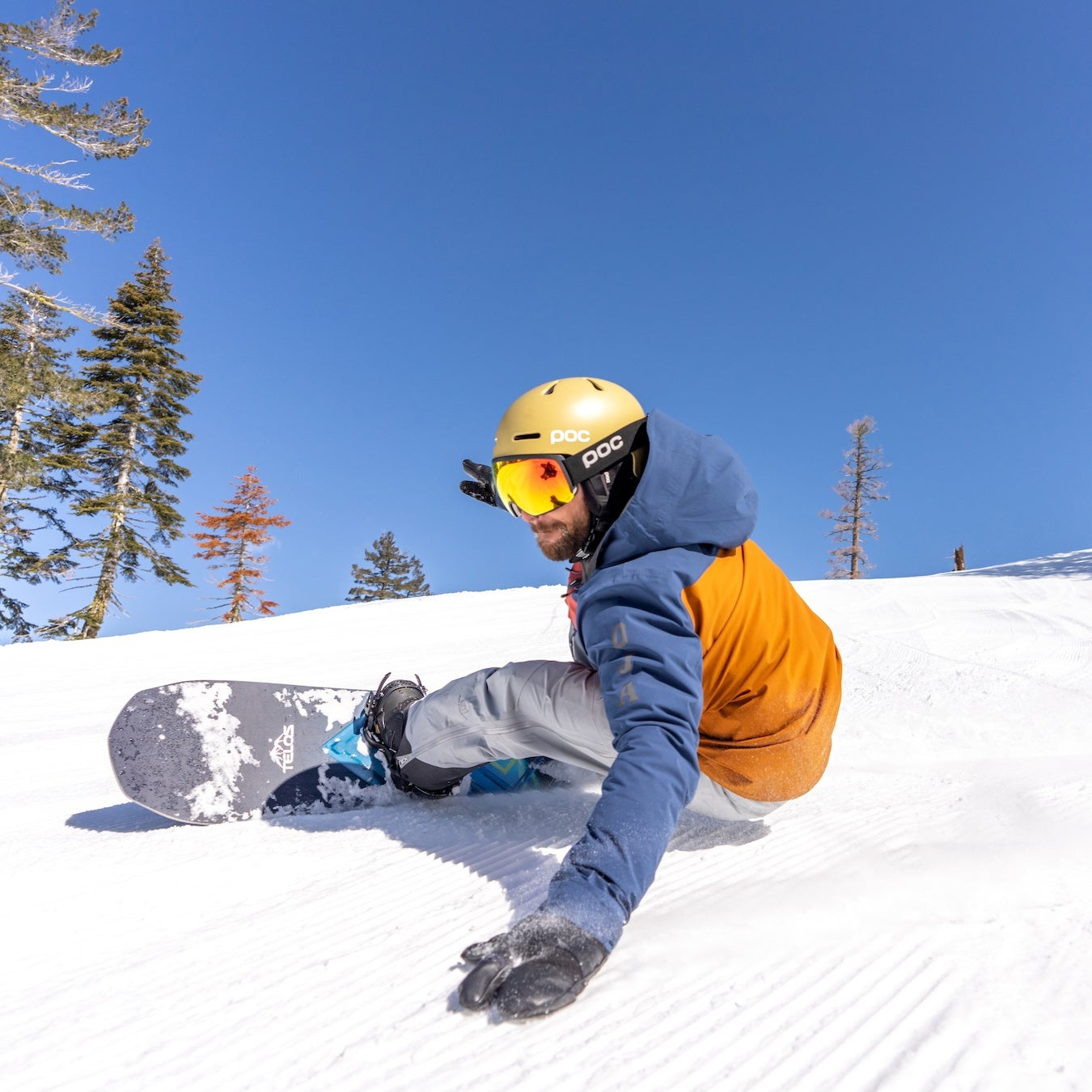Piecing together the right snowboard gear is like forming a rock band. Snowboards are the obvious frontmen: flashy, attention-grabbing, soaking up more limelight than they’re due. But even the best boards are nothing without boots and bindings, the underappreciated drummers and bassists that keep the jams cohesive and the crowd dancing. Below, you’ll find the makings of a killer rhythm section, no matter if you’re headlining the resort or touring the backcountry. These are our picks for the best snowboard accessories of 2024.
How We Test
Number of testers: 40
Number of products tested: 25+
States tested in: California, Nevada, Utah, Alaska, Washington, Wyoming
Countries tested in: Canada, Japan, Sweden
Number of Broken Boots: 2
Heli Days: 4
Lost Snowboard Bags: 1
This year, Outside’s Snowboard Test returned to Sugar Bowl, an unpretentious mom-and-pop Tahoe resort with some of the best freeride terrain in the Lower 48. Mother Nature cooperated with a deep snowpack, and the park crew responded with a fun, flowy terrain park, while ski patrol opened up the fabled Palisades, a spiny cliff face reminiscent of Alaska. During the week of the test, we had all sorts of conditions on tap–exactly what we look for while testing–ranging from light powder and Sierra cement to slush, corn, immaculate groomers, and crusty crud.
We couldn’t have asked for better testers, either. A crew of 40 riders joined the fray, ranging in age from early 20s to early 50s, and skill levels from solid intermediate to expert. Testers were mostly locals, including a splitboard guide for Blackbird Mountain Guides, several members of the Sugar Bowl park crew, a snowboard buyer for a local shop, banked slalom podium regulars, and a handful of snowboard coaches. While a ton of new blood kept the test fresh, the core of the crew consisted of test veterans, several of whom have been reviewing snowboard gear for Outside for nearly a decade.
Especially when it comes to boots and bindings, it’s important for testers to break in gear, test durability, and gather feedback beyond our weeklong test at Sugar Bowl. As such, we put this season’s new offerings to the test as much as possible before and after our test week. The gear you’ll find listed below was put through the wringer inAlaska, Utah, Washington, Wyoming, the Eastern Sierra, and even places farther afield like British Columbia, Canada and Japan.
After test rides, our gear nerds filled out feedback forms on all boots and bindings to assess everything from comfort and longevity to ideal applications and target audience. At the end of the whole process, our test director sorts through those feedback forms, crunches the numbers, and compiles the final reviews. Rest assured,the gear on this list is the best of the best.
Meet Our Lead Tester
Drew Zieff
Drew Zieff is a Tahoe-based freelance writer and a lifelong snowboarder. In addition to directing Outside Magazine’s snowboard test, a role he’s handled since 2016, he directs Backcountry Magazine’s splitboard test, waxes on the Natural Selection and snowboard culture for Whitelines Snowboarding, and nerds out on snowboard gear and travel for REI, Gear Junkie, Gear Patrol, and Popular Mechanics, among others. He spends his winters testing snowboard gear in his backyard backcountry zones or up at Palisades, as well as chasing stories and storms to snowboard meccas like Alaska and Wyoming, British Columbia and Japan. His summers? They’re mainly spent at his desk, sifting through review forms and spec sheets, compiling our snowboard reviews—although he occasionally disappears in his custom-built 2006 Chevy Express for a few days when there’s swell on the coast.
The Reviews: The Best Snowboard Accessories of 2024
Editor’s Choice: Rome Katana Bindings ($400)
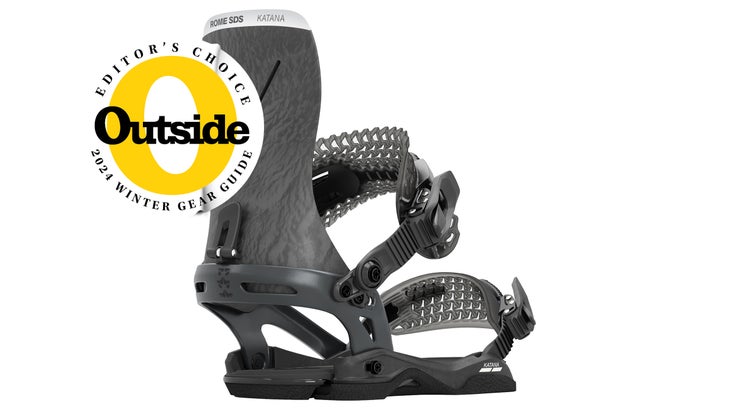
Size Range: S, M/L, L/XL
If you like to tweak your bindings as much as you tweak your grabs, peep the Rome Katana. This high-performance binding is ultra-adjustable thanks to Rome’s PivotMounts—modifiable ankle strap mounting hardware that enables riders to swap between eight ankle strap positions per side, yielding a total of 64 possible configurations. Raising the ankle strap provides more rapid-fire responsiveness, while lowering the strap position translates to increased range of motion and a surfier ride. Additional adjustability comes courtesy of composite highbacks that pivot and cant for a more ergonomic, fine-tuned fit.
“Experimenting with different strap and highback configurations will enable you to find what works best for you,” commented test director Drew Zieff, impressed by the versatility of the Katana system. “And if you’re swapping one pair of bindings between multiple boards in your quiver, or like to cruise one day and bomb everything in sight the next, the Katana allows you to make the most of your setup.”
Adjustability wasn’t the only reason the Katana sliced through the competition. All-mountain riders appreciated its versatility—it proved responsive in technical lines yet playful in the air, a balanced approach that comes courtesy of the Katana’s mid-flexing highback and asymmetrical chassis. The board’s cold-resistant, closed-cell foam padding beneath the baseplate also offers unreal shock absorption.“Great dampening,” reported snowboard guide Andrew Alissandratos. “I took them to Mach 10 and had no chatter.” Additionally, testers loved the geometric-patterned toe and ankle straps, which expand as you tighten the binding, providing a fit one Katana convert called “damn-near vacuum-sealed.”
Bottom Line: With more cushioning than the pillow aisle at Bed, Bath, and Beyond, the Katana is easy on the ankles of aging airtime addicts. Hyper-adjustable, these Rome bindings are also ready to rock’n’roll on damn near every board in your quiver. If you want our testers’ advice, pair them with the Editor’s Choice-winning Lib Tech Apex Golden Orca for the slay-anything setup of your dreams.
Ride Torrent Boots ($570)

Size Range: 7-13
There’s no braver gear tester than a boarder with blisters willing to shove his feet into fresh, foreign footwear. Cody Buccholz, a ripping rider, gourmet chef, and longtime board tester, did just that with Ride’s new Torrent boots, and his reports hint at the immediate comfort on tap. “These boots helped me forget about my blisters because of how well they lock your foot into place,” he said. While a dual-BOA lacing system is somewhat standard these days, Ride uses lacing guides centered on the tongue and forefoot that help maintain even lace tension. “I loved that I could keep the base of my foot tight and release pressure by popping the upper BOA on the lift,” gushed Buccholz. Wasatch backcountry hound, Kordell Black, echoed his sentiments: “I loved the inner liner’s lace system with the clip to the liner–it prevents pinch points.”
In addition to the lacing dynamics, a structured Intuition liner with cored ankle pockets and J-bar supports helped keep testers’ heels locked down, while supportive insoles and a cushy foam midsole ensured out-of-the-box comfort. Testers also dug the overall profile of the boot– “slim profile, perfect for big-footed riders,” reported Black–and the aggressively lugged Michelin rubber outsole, which Buccholz reported crushed steep bootpacks and icy sidecountry scrambles. Ride ranks flex at a 7 out of 10, which our crew found to be accurate. As a result, we recommend them for all-mountain chargers and freeriders as opposed to the freestyle contingent.
Ride also equipped the Torrent with a velcro flap on the calf, an addition billed as a means to fine tune the fit and accommodate both smaller and larger calf shapes. Bonus: One tester found that the flap also functioned as an “unintentional walk mode” while splitboarding. However, another rider with thin calves who loves to crank his boots extremely tight relayed that the velcro popped and released before he could reach his preferred level of snugness.
Bottom Line: Next-level ride quality make these new Ride boots a top pick for our testers. Next-level focus on sustainable materials, like an EVA midsole derived from sugarcane and plant-based reinforcements on the toe and heel, make them a top pick for our planet.
Ride Duffel Bag ($150)

Volume: 80L
“Before testing this Ride bag, I thought the perfect snowboard duffel didn’t exist,” said Zieff. “Now I know better, and I don’t go on shred trips without it.” The 80-liter duffel is masterfully compartmentalized by the board nerds at Ride: the main section stashes clothes and outerwear, the burly bottom compartment is a perfect quarantine for rank, wet boots, a fleece-lined zippered pocket protects your goggles, and several smaller gear pockets and partitioned see-through mesh compartments allow for the organization of easy-to-lose items like chargers and sunscreen. The size isn’t overkill if you’re carpooling with friends on a powder day, and we happily used it on day trips and weeklong missions alike. Lug it like a duffle or deploy the shoulder straps for backpack mode.
Bottom Line: A sleek, well-designed duffel that’s purpose-built for shredding, you’ll probably end up using this radical piece of luggage year round.
Jones Orion/Aurora Binding ($350)
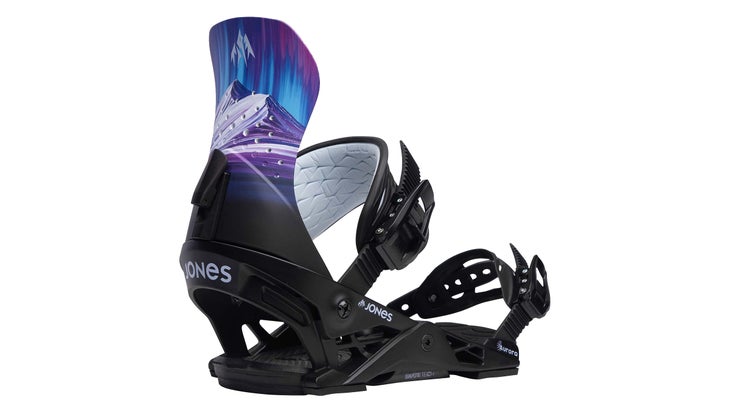
Size Range: M-L (Jones Aurora available in S-M)
Back for its second season, the Orion binding caters to all-mountain cruisers and creative freeriders who crave a responsive, reliable ride with an adjustable, mid-soft flex. And new for this season: Jones launched a women’s version, the Aurora, of this tester-favorite, doubling the overall size range to be more inclusive of riders with smaller boots.
Both the Aurora’s and the Orion’s highbacks are stiffer at the heel cup and softer towards the calf, offering a great balance of performance and play. “When transitioning from edge to edge, the highback gives you all the support you need,” reported one rider strapped into the Orion. When you start playing with other directions—off-axis tweaks, contorted carves, nose or tail presses, et cetera—the softness toward the top of the highback lets you twist like a yogi.”
This edge-to-edge prowess also comes courtesy of Now Snowboarding’s revolutionary SkateTech, introduced by the British Columbia binding builder in 2012, which is at the core of all of Jones’ bindings. A baseplate pivots around the disc housing like a fulcrum, efficiently leveraging rider weight and transferring energy to four bushings at the corners of each binding. Not only does this system yield what our tester called “instantaneous response,” but the rubbery, dampening bushings also “absorb more chatter than the NSA.” Between the bushings and a thick EVA foam footbed, the Orion is so comfortable it fits the bill for “first-to-last-chair riding called for by late season powder days and closing weekend festivities.” And if you like to customize your setup, the bushings can be swapped out for a stiffer or softer ride feel. What’s more, the flexy-yet-supportive ankle straps are customizable, too: swap the left and right ankle straps to bounce between freeride and surf modes. Freeride-mode locks in the ankle for straight-lining steeps and tackling technical faces, while surf-mode frees up range of motion for slaying side hits and flowy pow days. Pro tip: If you’re looking for a slightly stiffer all-mountain binding that utilizes the same NOW Snowboarding SkateTech, check out the NOWs Drive.
Bottom line: The Orion is a customizable, comfortable, and approachable binding that can cruise one day and charge the next.
Union Atlas Pro ($450)
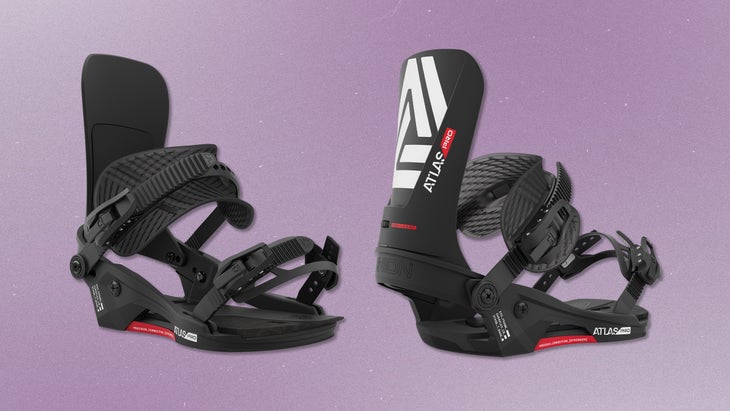
Weight: 2 lbs. per binding (M)
Size range: S-L
The versatile, bombproof, all-mountain Union Atlas is one of our all-time favorite bindings, so when Union debuted the Atlas Pro for 2023, our testers were damn near salivating. This drool-worthy build sports the same responsive highback (but stiffened for 2023) and Duraflex baseplate as the Atlas. However, the Atlas Pro is 15 grams lighter per binding and more responsive thanks to an ultra-reactive carbon footbed, streamlined toe cap, and more rigid, hypersensitive ankle straps. “The Atlas Pro is a notch stiffer, lighter, and more responsive than the Atlas. Pair it with a big mountain board or beefy all-mountain shape and the carbon gas pedals let you approach light speed,” said a tester who spent the majority of last season on the Atlas and this season on the Pro. His recommendation: “Intermediate and up all-mountain riders who appreciate a balance of comfort and response will prefer the cushiness and canting of the Atlas, while aggressive freeriders and slow-sign-ignoring resort rippers will fall in love with the streamlined, elite build of the Atlas Pro.”
Bottom line: A top-of-the-line binding for advanced riders who crave quality and won’t compromise on response.
Bent Metal Binding Works Stylist ($280)
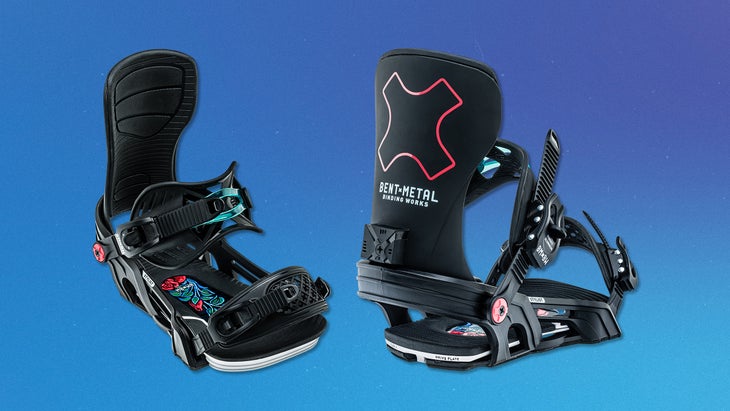
Size range: M, L
Shred the mountain, not your budget with the women’s Stylist, an all-mountain binding that’s as capable as it is affordable. Performance stems from a boot-hugging, asymmetric highback; soft-flexing, compressible ankle straps; and a medium-stiff magnesium and EVA foam Drive Plate. Bent Metal’s technical riff on a traditionally simple binding tech, Drive Plates are swappable, padded, energy-transferring footbeds crafted using the same layering and lamination techniques as modern snowboards. “The Stylist Drive Plate is responsive yet cushy. They have enough padding underfoot for comfort on hard landings, but enough structure for high-level performance and quick response,” testified a snowboard coach who felt the design could take on anything from “street-style rails to bumped-out chutes.” While she lamented the lack of an adjustable heel cup, overall impressions were through the roof from the jump, and that surprised her. “I am picky about bindings, and even when I get a new pair of the bindings I’ve had for years, they take a few days to break into where I am happy with them. So I was stoked to like these by my second run,” she said. She recommended the Stylist for women who demand “high performance as well as high comfort levels” from their kit.
Bottom line: Bent Metal’s affordable, all-mountain Stylist suits riders who want to rip the entire mountain without breaking the bank.
Thirtytwo TM-2 Jones ($425)

Size range: 6-13
If you don’t have space in your board bag—or budget—and need a single pair of boots that can handle touring and resort riding alike, check out the TM-2 Jones. This boot is capable of pinning it down Palisades’ fabled fingers one day and skinning deep into Desolation Wilderness the next, thanks to an articulated calf and rugged outsole that allows the otherwise downhill-oriented boot to tour and scramble comfortably. The TM-2 is a softer, more versatile, and more approachable option than the beefier, ultra-stiff, mountaineering-ready Jones MTB. Still, a Sierra-scaling splitboard guide rated them high on traction and backcountry utility. He dug the “Vibram sole and crampon-compatible heel, combined with a reinforced toe for kicking steps.” A lack of breakable lacing parts was also appreciated. “I love laces and found the tension strap to be super utilitarian as a splitboarder,” he said, although he did wish the laces went higher on the tongue. All told, he called the TM-2 Jones his “favorite backcountry boots,” and noted that snowboarders who can justify multiple pairs of boots may reserve the TM-2 exclusively for touring applications. While he appreciated the ride feel in-bounds, he admitted to preferring more streamlined but still responsive boots like the Vans Verse or Ride Insano in pure resort scenarios. However, on shred trips that involve both the front and backcountry, the decision is clear.
Bottom line: A versatile, stiff boot for riders who alternate between touring and tearing the resort to shreds. It has mountaineering chops, but it’s still a snowboard boot at heart.
Burton SLX ($670)
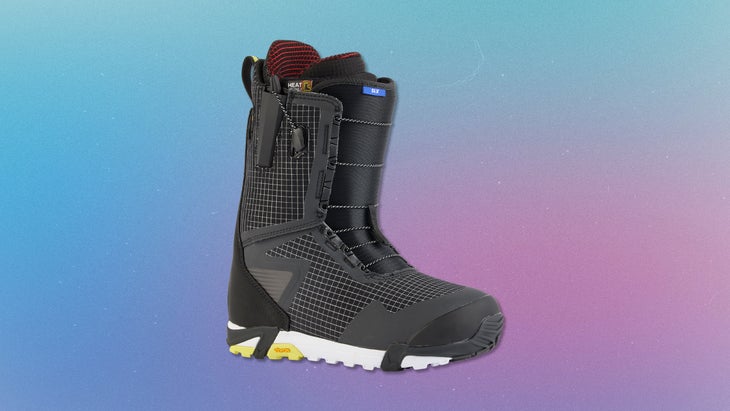
Size range: 7-13
Burton’s SLX is more overflowing with tech than Christmas stockings in Silicon Valley: a welded backstay, a Dyneema-wrapped shell, and a Carbitex-buttressed ankle zone give the boots their backbone. Usually, boot builders reserve such bells and whistles for ultra-stiff, freeride-focused boots, but the SLX plays the middle ground with grace, and the resulting flex is responsive enough for technical charging and still tweakable when airborne. “I tested these boots on sled laps and a steep heli day in Alaska, spring storm and corn cycles in Tahoe, and resort days in Utah, riding everything from pow to ice to side hits,” relayed an all-mountain tester. He appreciated the workable yet reliable flex, found Burton’s proven yank-to-tighten Speed Zone lacing simple, secure, and easy to adjust on the fly, and reported: “the nominal outsole footprint makes toe and heel drag a thing of the past.”
One point of concern: after 20-plus days of testing this spring, we did notice a slight crease forming where the upper meets the lower, and we’ve read a few customer reviews citing newer construction doesn’t last quite as long as older SLX iterations. Also, Burton has plenty of cheaper boots in a similar medium stiffness profile—we’re big fans of the Photon if you want to save some dough. That said, if you’re an advanced all-mountain rider who spends more than 30 days annually on snow, the high-performance SLX is well worth the high price tag.
Bottom line: A premium all-mountain boot that’s maxxed out with tech and boasts a minimal footprint.
How To Buy Snowboard Gear
Shopping for snowboard boots, bindings, and accessories can be overwhelming. Here are a few tried-and-true tips to make the process as smooth as possible.
If possible, shop for boots before you shop for boards and bindings. Some boots, like the Burton SLX, have compact footprints, which means you’re less likely to have toe or heel drag on a narrower board. If you end up buying a boot with a bigger footprint, or you have a size 10.5 boot or higher, you may want to consider a mid-wide, wide, or volume-shifted board.
Invest in insoles. Even high-end snowboard boots often sport garbage insoles (as reported by a tester who fits boots for a local shop), and one of the best ways to improve fit, comfort, and performance is with an aftermarket insole. We’re partial to Green Superfeet. Oh–and don’t forget to heat mold those new boots, too!
If you can, support your local snowboard shop. If you prefer to shop online, buy from a reputable online retailer like REI or Backcountry, that has a decent return policy.

